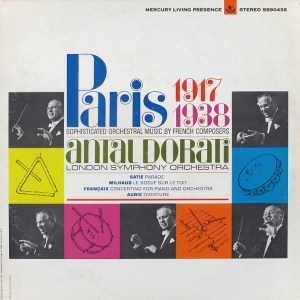More Music Conducted by Antal Dorati
What to Listen For – Side to Side Differences

Super Hot Stamper sound for Eric Satie’s wonderfully eccentric Parade (and the Auric piece as well) can be found on this rare original promo copy of Mercury 90435, a record that was previously on the TAS List if I’m not mistaken.
It certainly deserves to be. The sound is BIG and OPEN, and like so many Mercury recordings with the London Symphony, it’s rich and full-bodied, not thin and nasally as is so often the case with their domestically recorded releases. Above all the sound is transparent, lively and dynamic.
In many ways this album would certainly serve quite well as an audiophile Demo Disc: the timbre of the wide array of instruments used is (mostly) Right On The Money.
Check out the lengthy and humorous producer’s notes for the sessions below. And people think The Beatles discovered experimental sounds in the studio.
With one small exception: the brass doesn’t have all the weight of the real thing, and for that we have deducted one plus from our top grade of three.
Side one has classic Bad Mercury Sound — so screechy, hard and thin. How many audiophiles own records like this and don’t know that the sound of one side is awful and the other brilliant?
Since so few have ever commented publicly about such matters — and even supposedly knowledgeable audiophile reviewers never bother to even bring up the subject of one side versus the other — one must conclude that this is a subject that has yet to pierce the consciousness of most of our audiophile brethren, especially the ones who haven’t yet discovered this site.
Now’s a good time to start. Dig in, you may be surprised by what you find.
